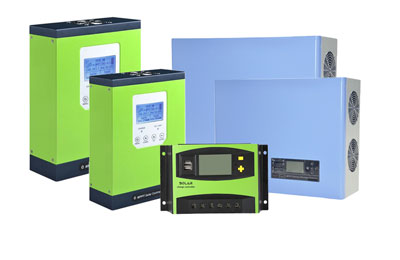The most common use of a solar charge controller is to provide load power for solar inverters and to charge energy storage devices in solar power systems. Before buying a solar charge controller, we need to have a general understanding of this product, to choose a great solar charge controller with the most favorable price.
Tips for selecting a solar charge controller
Choosing the right solar charge controller is crucial for the efficiency and longevity of your solar power system. Here are some tips to help you select the best charge controller for your needs:
- Determine the system voltage: Identify the voltage of your solar power system (12V, 24V, 48V, etc.). Ensure the charge controller is compatible with your system voltage.
- Controller type: PWM (Pulse Width Modulation), more affordable and suitable for smaller systems. Good for solar panels and batteries with the same voltage.
- MPPT (Maximum Power Point Tracking), is more efficient and ideal for larger systems. Extracts maximum power from solar panels, especially in varied weather conditions.

- Current rating: The charge controller's current rating should be higher than the short-circuit current of the solar array. A general rule is to add a 25% safety margin to the maximum current output of your solar panels.
- Load control: Decide if you need a solar charge controller with load control capabilities, which can directly power DC loads and protect the battery from over-discharge.
- Temperature compensation: Look for a charge controller with temperature compensation if your batteries are exposed to significant temperature fluctuations. This feature adjusts the charging voltage according to temperature changes, prolonging battery life.
- Display and monitoring: A charge controller with a display screen can provide real-time data on system performance, including voltage, current, and charging status. Some controllers offer remote monitoring capabilities via Bluetooth, Wi-Fi, or Ethernet, which can be useful for larger or off-grid installations.
- Safety features: Ensure the solar charge controller has necessary protection features such as overcharge, over-discharge, reverse polarity, and short-circuit protection.
- Expansion capability: If you plan to expand your solar power system in the future, choose a charge controller that can handle additional solar panels and higher current loads.
- Brand and warranty: Choose a reputable brand with good customer support and a comprehensive warranty. This ensures reliability and assistance in case of any issues.
- Efficiency: Consider the efficiency of the charge controller. Higher efficiency means more of the solar power generated will be used to charge the batteries.
- Ease of installation: Some solar charge controllers are easier to install than others. Check the installation requirements and whether you need additional components or professional installation.
- Cost: Balance the cost with features and performance. While MPPT controllers are more expensive, their higher efficiency can justify the cost for larger systems.
By considering these factors, you can select a solar charge controller that meets your system's needs, ensuring efficient and reliable operation of your solar power system.
